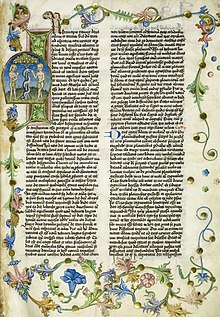Theophilus ben Ananus

Theophilus ben Ananus (Hebrew: תפלוס בר חנן) was a high priest at the Herodian Temple in Jerusalem .
Live and act
According to the Jewish antiquities , written by the Jewish writer Flavius Josephus between 93 and 94 AD, Theophilus ben Ananus held this office from 37 to 41 AD.
After Josephus, he was a member of one of the richest and most influential Jewish families in Jesus' day . He was a son of Annas , according to Josephus high priest in the years 6-15 AD.
Theophilus ben Ananus had four brothers, Eleazar , Jonathan , Matthias and Ananus , all of whom also played an important role in the Jerusalem temple and held the office of high priest.
He was the brother-in-law of Kajaphas . According to the New Testament, Kajaphas is said to have played a key role in the condemnation of Jesus of Nazareth. According to Josephus, Vitellius replaced the ruling high priest Jonathan with Theophilus, his brother, during a three-day stay in Jerusalem. Theophilus ben Ananus' son, Matthias, was also appointed high priest. Matthias was the penultimate high priest before the destruction of the Jerusalem temple by the Romans and held the office from 65 to 67. The temple was destroyed during the tenure of Ananus ben Ananus, brother of Theophilus ben Ananus.
According to an article published in the Israel Exploration Journal in 1984, the historical person Theophilus ben Ananus is archaeologically proven. A bone box was found with the inscription "Johanna granddaughter of Theophilus, high priest".
The non-fiction author Richard Anderson says in his book "Who are Johanna and Theophilus ?: The Irony of the Intended Audience of the Gospel of Luke", the addressee of the Gospel of Luke was Theophilus ben Ananus been.
See also
References and comments
- ↑ The writing is based on a bone box found in 1984 of a granddaughter of the high priest. Israel Exploration Journal. 36 (1/2): 39-44
- ↑ | Rainer Metzner The Celebrities in the New Testament: A Prosopographical Comment p. 236
- ↑ Louis H. Feldman, Gåohei Hata, Josephus, the Bible, and History, 203
- ^ Full text of "Flavius Josephus Works: Antiquities, War, Apion, Life. Translated by Heinrich Clementz"
| personal data | |
|---|---|
| SURNAME | Theophilus ben Ananus |
| BRIEF DESCRIPTION | Jewish high priest |
| DATE OF BIRTH | 1st century BC Chr. |
| DATE OF DEATH | 1st century |